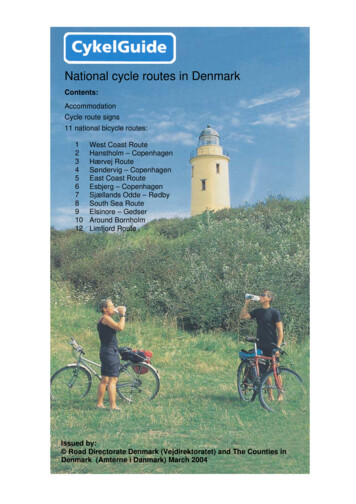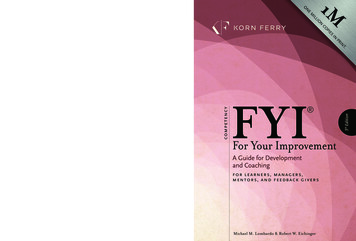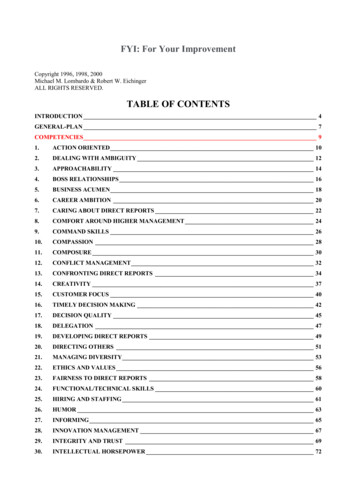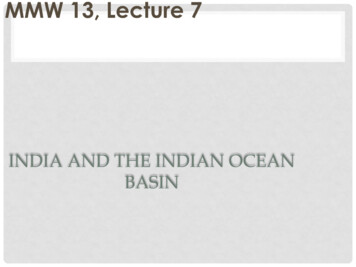
Transcription
CycelGuideNational cycle routes in DenmarkContents:AccommodationCycle route signs11 national bicycle routes:1234567891012West Coast RouteHanstholm – CopenhagenHærvej RouteSøndervig – CopenhagenEast Coast RouteEsbjerg – CopenhagenSjællands Odde – RødbySouth Sea RouteElsinore – GedserAround BornholmLimfjord RouteIssued by: Road Directorate Denmark (Vejdirektoratet) and The Counties inDenmark (Amterne i Danmark) March 2004
AccommodationThere is a good selection of accommodation to suit every pocket. At the slightlymore expensive end of the range there are hotels and inns, where a double roomtypically costs from DKK 400 upwards. A list is available from tourist informationoffices or on the Internet.Bed & Breakfast (B&B) is becoming increasingly common in Denmark – includingalong cycle routes. See the leaflet entitled "B&B i DK" for a summary or ask thelocal tourist information office. The leaflet entitled "Bondegårdsferie, Ferie pålandet", which is available free of charge from the National Association forAgritourism, also provides information on a variety of accommodation.Danish youth hostels are very comfortable and offer family rooms. In peak seasonbetween 1 June and 1 September it is advisable to book in advance. "Vandrerhjemi Danmark" from Danhostel provides information on more than 100 youth hostelswith 1-5 stars and is available free. It is also possible to book online.Campsites welcome cyclists and some have a special area for tents where cars arenot allowed. Some campsites also let chalets. "Camping Danmark" published bythe Danish Camping Board costs DKK 95 and provides information on more than500 campsites with 1-5 stars.To stay at a youth hostel or campsite, you will need a membership/camping card(which can be purchased on arrival, however). Overnight accommodation costsaround DKK 100 per person at a youth hostel and DKK 50 per person at a campsite.In recent years a network of cheap tent sites has been built up (free or DKK 15 pernight). Please see "Overnatning i det fri 2002-03, teltpladser ognaturlejrpladser" published by the Danish Outdoor Council's Experience ExchangeGroup. The book costs DKK 95.Bikes and public transportPublic transport in the form of trains, buses and ferries can be used to reach yourchosen holiday area and save a bit of energy en route.Taking your bike with you on the train is now easier and cheaper. The maximumfare from Skagen to Gedser is DKK 50. Children under 10 years of age can take abike with them free of charge. Intercity trains serve the whole country and take alimited number of bikes. Advance bookings are required between 1 May and 31August (DKK 15). At the weekend there are also interregional trains, wherereservations are not required. A standard bike "clip card" can be used for alljourneys. From summer 2002 onwards the Storebælt line will have four departures aday with space for non-folding trailers, tandems and special bikes to replace theStorebælt bus. Ordinary bikes can go by Intercity train from Korsør or Nyborg. TheØresund line has space for 16 bikes per train, with departures every 20 minutes.Trailers and tandems can also be taken on Øresund trains.See the timetable and the leaflet entitled "Cykler i tog", which is available from allstations, for further details. The yellow posters of departure times on display atrailway stations also indicate which trains take bikes.A limited number of bikes can be taken on regional buses outside the Copenhagenarea and some long-distance coaches. Finally, bikes can be taken on all ferries.The country codeIf you take your bike off the cycle routes and public roads, it is a good idea to knowthe country code.Cycling is permitted around the clock on roads and paths in public woods. Cycling isalso permitted in private woods of more than 5 hectares in size, but only between 7
am and sunset, and then only on roads and surfaced paths. Cycling is permitted onall roads and surfaced paths in open countryside as well unless prohibited by a(legal) sign.Sleeping in tents is only permitted on campsites and tent sites (unlike in Norway andSweden, there is no general right of access to private land), and you must keepaway from residential buildings in woods and open countryside. Fires may only be litin designated places.
CYCLE ROUTE SIGNSCycle routes are signposted everywhere with a symbol depicting a white bike on ablue background. This symbol, used together with a number, name or logo, marksthe route. This enables the signs to combine separate paths, forest tracks andpublic roads into routes. Route numbers and logos appear in a box, just like theroute numbers on roads. The specific rules for signposting are explained in"Vejregler for vejvisning på cyckel- og vandreruter" published by the RoadDirectorate in 2000 and can be found on www.vejregler.dk.National routes can be identified by the national colours: white numbers on a redbackground. They are numbered 1 to 15. Regional routes have white numbers on ablue background and are numbered 16-99. Both national and regional routes canhave a name as well as a number. Finally, there are local routes with the same blueand white sign as regional routes, but numbered 100-999. Local routes can have aname or white logo instead of a number.Remember the number/name/logo of the route so that it is easy to find your wayusing the signs. A sign without an arrow means that you have to go straight on.Route numbers are also shown on regional and local cycle maps, and are used inthis and other guides.National routeRegional routeLocal routeFingerpost for national routeFingerpost for services
West Coast Route560 kmThe West Coast Route from Rudbøl to Skagen offers surf, vast beaches, thewind in your hair and the tang of seaweed and salt. The way the coastlinechanges from tidal flats to dunes and soft, sandy beaches is a perfectillustration of a coherent landscape on a grand scale. But there is more thanjust water and sand to look at. Away from the coast there are culturallandscapes, deserted dune plantations and lively campsites. Man'srelationship with the sea is a constant theme. The route is best cycled fromsouth to north with the southwest wind at your back. Wide tyres arerecommended for the gravel tracks.With the bleating of sheep and cries of birds for company, follow the West CoastRoute along the Vadehavet (Wadden Sea) past the Højer Sluse floodgate toEsbjerg. There is shelter from the wind on the car-free tracks that the route followson terraces along the dikes, but you have to go up onto the dike to see the WaddenSea, where birds feed in large and small flocks when low tide opens up the ocean'slarder.The Wadden Sea is one of Northern Europe's most important wetlands. All sorts ofrare birds rest there en route from Scandinavia to the big wide world. You may belucky enough to see one of the small number of Danish storks shuttling back andforth between nest and larder. The route also crosses the Varde Å, the only river inNorthern Europe to be influenced by tides. But before then there is an opportunityfor some exciting island hopping:Romø can be reached without getting your feet wet or risking seasickness, as thereis a causeway. At Toftum in the north of the island you can visit Kommandørgården,an old sea captain's house that has been turned into a museum about the days whenmany of the island's men went whaling, etc., on the high seas. The whales'jawbones they brought home were used as gardenfences, as can be seen at Juvre, a kilometre to thenorth. In the middle of the island lies the tourist resortof Lakolk, which has changed somewhat since theparson from Skærbæk opened the first seaside hotelin 1898. Back then the guests crossed to the islandby boat and were taken to the hotel in a horse-drawntrain. Traces can still be seen of the old rails that ranacross the moor between Kongsmark and Lakolk.Cycle route on the beach
There are no great distances to cycle on Mandø, but you can find out what life is likeon a small island, enjoy nature and discover history in an old skipper's house datingback to 1831. Don't try cycling over – take the Mandø Bus, i.e. the tractor fromVester Vedsted, instead.Fanø is reached by ferry from Esbjerg. Follow Regional Route 5 south straightawayon the broad path along the road. To get to Sønderho, go through Rindby and thedune plantation. The well-preserved fishermen's cottages and skippers' houses ofthis intimate village in the dunes offer a rare idyll in the Denmark of today.Continue from Esbjerg past the 9-metre sculpture by Svend Wiig entitled "ManMeets the Sea". As it passes through the counties of Ringkøbing and Viborg, theroute is characterised by dune-covered tongues of land, which divide the harsh westcoast from the gentler fjords behind, where many species of bird flourish.Sand Sculpture Festival in BlokhusThe Holmsland spit divides theharsh west coast from the gentlefjord behind, where many species ofbird flourish – don't forget yourbinoculars. You could also stop offat Abelines Gård in Haurvig, whereyou can soak up the atmosphere ofa wreck master's house in the olddays and enjoy a cup of coffee. Thefarmstead was built in 1854-71 andAbeline lived there alone with herfive children from when her husbanddied in 1904 until her own death in1957.Further on in Søndervig you pass lots of beautiful old holiday cottages. The firstseaside hotel was built there in 1884. This is where you will also start to noticeconcrete bunkers on the beach, scattered like big, weathered sugar lumps along thecoast between there and Skagen. They were part of the Germans' Atlantic Wall,defensive fortifications built in 1943-45.After a number of bird sanctuaries you arrive at the wind-swept spit that is home tothe village of Thyborøn, where you just have to see the unique Sneglehus (SnailHouse) on Sneglevej (Snail Road), which is decorated with all good things from thesea both inside and out. It also houses the country's largest collection of ships inbottles.The distinctive features of the coastal landscape in the form of steep cliffs can beexperienced at Bulbjerg and further on at Rubjerg, where Mårup Kirke can be seenteetering on the brink. As the prevailing philosophy is to let nature take its course,the church and the skeletons in its small cemetery will soon fall into the sea.The forces of nature play a major role in the lives of fishermen, and at Stenbjerg andVorupør they have made do without a harbour for many years by pulling their fishingboats up onto dry land – a laborious task, but a picturesque sight. The riches of thesea can be studied at Nordsømuseet (North Sea Museum) in Hirtshals.
Picturesque is also a good word to describe Svinkløv Badehotel, a wooden seasidehotel painted grey and standing solid and windswept among the dunes. Inside youwill find the loveliest of pastel colours and a fantastic light off the sea. Surprisinglyenough, there is a small beech wood growing in the back garden.Every desert has its oases, and the same applies to the fertile Fosdal valley with itsfragrant honeysuckle a little to the north.The West Coast Route ends on Hulsigstien on its way into Skagen near theTilsandede Kirke (Buried Church), which is an excellent illustration of the theme ofthis route: man's battle to gain a foothold in the face of harsh nature. Råbjerg Mileis an impressive desert-like area of dunes that migrates 20 metres a year.North Sea Cycle RouteThe West Coast Route forms part of the European North Sea Cycle Route,which was the first of 12 European routes to be opened in its entirety and hasa total length of around 6,000 km. As the name suggests, it follows the coastof the North Sea and offers everything in the way of coastal landscapes frombeaches to cliffs, as well as bathing and camping amenities, and fishing cultureancient and modern. It is signposted as National Route 1 in Denmark,Norway, Scotland, England and Holland.As well as including the entire West Coast Route, the Danish section alsocovers part of the East Coast Route from Skagen to Grenaa, making around800 km in total in Denmark.A free map leaflet is available from the county councils, while TuristgruppenVestjylland ( 45 7528 7400) sells a Cycline map book: "På cykel langsJyllands vestkyst". See also www.northsea-cycle.com.
Hanstholm – Copenhagen420 kmThis route takes you from the country's largest fishing port in Hanstholm tothe old trading port in the Danish capital. It runs from the wild North Seathrough farmland and woods, past manors and along beaches, toCopenhagen. It offers a cross-section through the varied Danish countryside,making it a perfect introduction for Danish or foreign tourists who want toexperience Denmark on two wheels.Cycle south from windswept Hanstholm in the shelter of Vildtreservatet (the GamePreserve), where dunes, moorland, lakes and bogs provide the setting for a wealthof rare birds and other animals.South of Thisted the route turns and crosses Limfjord to Mors, which, with all itsdifferent types of countryside, is said to be God's model for Jutland. The north of theisland has steep moler cliffs, Hanklit near the Gullerup Gamle Færgekro inn andFeggeklit, where there is a ferry across Feggesund. The south of the island ischaracterised by agriculture, as well as meadows, bird sanctuaries and beaches.Route 2 runs straight across the island, but you can also opt to make an extra looparound the island on the Solruten or Sun Route – yes, it really is called that, evenwhen it is raining!After leaving Mors the route winds it way through the labyrinths of Limfjord and intothe mild valleys of Jutland. Jernbanestien (the Railway Path) across the Sallingpeninsula between Glyngøre and Skive allows you to experience the agriculturalland behind the towns, and the road down to Viborg takes you along the edge ofHjarbæk Fjord.You skirt the lakes at Viborg and join anice, comfortable railway path thatgoes through Bruunshåb and Vejrum.Before long a strange geologicalformation appears like "The FlyingDutchman" i
The book costs DKK 95. Bikes and public transport Public transport in the form of trains, buses and ferries can be used to reach your chosen holiday area and save a bit of energy en route. Taking your bike with you on the train is now easier and cheaper. The maximum fare from Skagen to Gedser is DKK 50. Children under 10 years of age can take a bike with them free of charge. Intercity trains .











